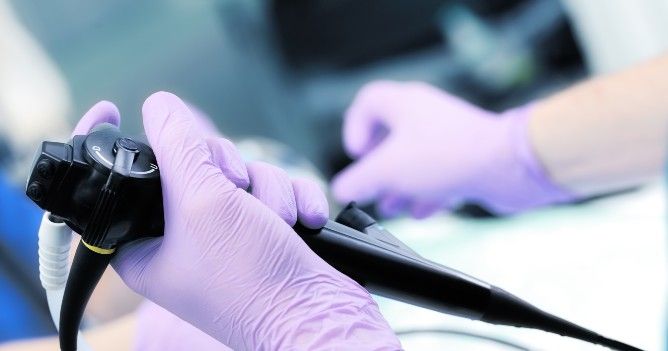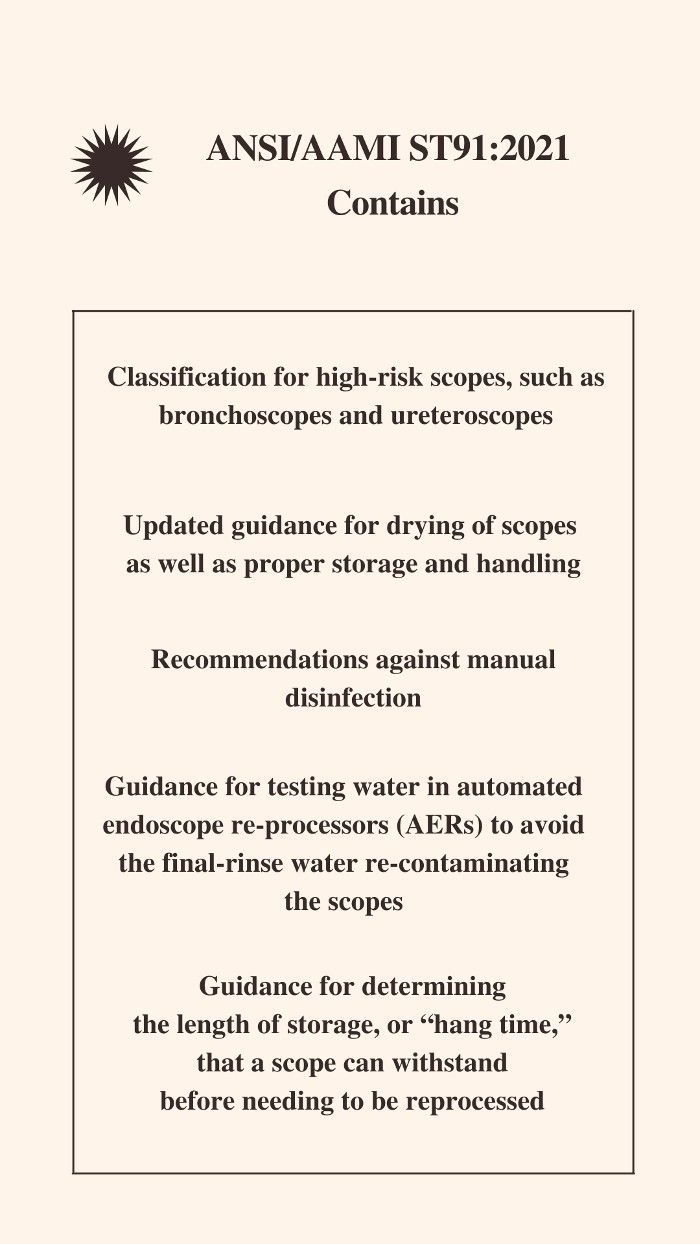Preventing HAIs with Updated Sterilization and Quality Control Processing
ANSI/AAMI’s update on endoscope processing is backed by rigorous scientific evidence.
(Adobe Stock)

After 7 years, the American National Standards Institute (ANSI) and the Association for the Advancement of Medical Instrumentation (AAMI) have updated their guidance for disinfection/sterilizing, storage, and quality control procedures of medical devices. The recently published document, ANSI/AAMI ST91:2021, Flexible and Semi-Rigid Endoscope processing in Health Care Facilities, discusses the processes and procedures to avoid multidrug-resistant organism infection outbreaks related to flexible endoscopes. This updated guidance is intended for any location these instruments are used.
Because of the increased number of health care–acquired infections (HAIs) related to endoscopes, a panel of more than 100 experts helped create this guidance.
“This revision took many years (thanks to the pandemic), and we had many stakeholders from industry, end users, regulatory, professional associations, and even clinical providers that came together to review the entire document,” Damien Berg, BA, BS, CRCST, AAMIF, vice president of strategic initiatives for the Healthcare Sterile Processing Association (HSPA), and a member of AAMI Endoscope Preprocessing Working Group (EPWG) that developed the guidelines, wrote in a statement to Infection Control Today® (ICT®).
Proper cleaning, storage, and handling of the endoscopes are vital for avoiding (HAIs), and the new guidance expands on those topics as well as the transporting. The guidance adds revisions to leak testing recommendations and clarifies cleaning and inspection steps. A few more key issues covered in the ANSI/AAMI ST91:2021 include classifications for high-risk scopes, such as bronchoscopes and ureteroscopes, and updated guidance for drying of scopes and recommendations against manual disinfection [Figure].
Key points in the ANSI/AAMI updated guidance.

“While there are many updates and changes, there are 4 takeaways that definitely are changes for the Sterile Processing departments, [which are] drying, storage, hangtime, visual inspection, and HLD vs Sterilization depending on the classification and use of the device,” Berg wrote to ICT®. “Each one will have an impact on how we process the scopes and how we ensure that the patient is getting the best in reprocessing.”
A few of these changes will be significant for some facilities, “but for all the right reasons,” Amanda Benedict, BA, MA, vice president of standards with AAMI, said in a written statement to ICT®. “By adopting these updates, all facilities that use reusable flexible endoscopes or semi-rigid operative endoscopes are ensuring that their processing procedures are backed by rigorous scientific evidence and the industry’s best practices for staff and patient safety.”
The importance of this updated guidance is for all sterile processing professionals, who “now have the fuel to be the spark for the change in their facility to implement more quality processes.” Mary Ann Drosnock, MS, CIC, CFER, RM (NRCM) cochair of EPWG, and Director at Healthmark Industries.
The document contains 11 annexes and a bibliography of 379 references, including peer-reviewed literature and references to the FDA MAUDE database. Susan Lacik, BS, CRCST, CIS, ACE, CHL, FCS, a clinical educator with HSPA, wrote a comprehensive article, published in AAMI, examining this important and in-depth update titled “A Closer Look at ST9:2021 for Endoscope Processing.”
“Mitigating these risks hinges on proper care and handling—from point of use through all reprocessing steps (including complete drying after high-level disinfection) and then to safe transport of the devices for patient use,” wrote Lacik.
Together We Rise: Why AORN Expo 2025 Is a Must for Every Perioperative Nurse
March 31st 2025From April 5 to 8, 2025, thousands of perioperative nurses will gather in Boston for the 2025 AORN Global Surgical Conference & Expo—a transformational experience designed to elevate nursing practice, build lifelong connections, and advance surgical care.
Vet IP Roundtable 2: Infection Control and Biosecurity Challenges in Veterinary Care
March 31st 2025Veterinary IPs highlight critical gaps in cleaning protocols, training, and biosecurity, stressing the urgent need for standardized, animal-specific infection prevention practices across diverse care settings.
Invisible, Indispensable: The Vital Role of AHRQ in Infection Prevention
March 25th 2025With health care systems under strain and infection preventionists being laid off nationwide, a little-known federal agency stands as a last line of defense against preventable patient harm. Yet the Agency for Healthcare Research and Quality (AHRQ) is now facing devastating cuts—threatening decades of progress in patient safety.
The Sterile Processing Conference Survival Guide: How to Make the Most of Your Next Event
March 25th 2025From expert speakers to cutting-edge tools, sterile processing conferences, like the 2025 HSPA Annual Conference and the SoCal SPA's Spring Conference, offer unmatched opportunities to grow your skills, expand your network, and strengthen your department's infection prevention game.
Redefining Material Compatibility in Sterilization: Insights From AAMI TIR17:2024
March 24th 2025AAMI TIR17:2024 provides updated, evidence-based guidance on material compatibility with sterilization modalities. It offers essential insights for medical device design and ensures safety without compromising functionality.